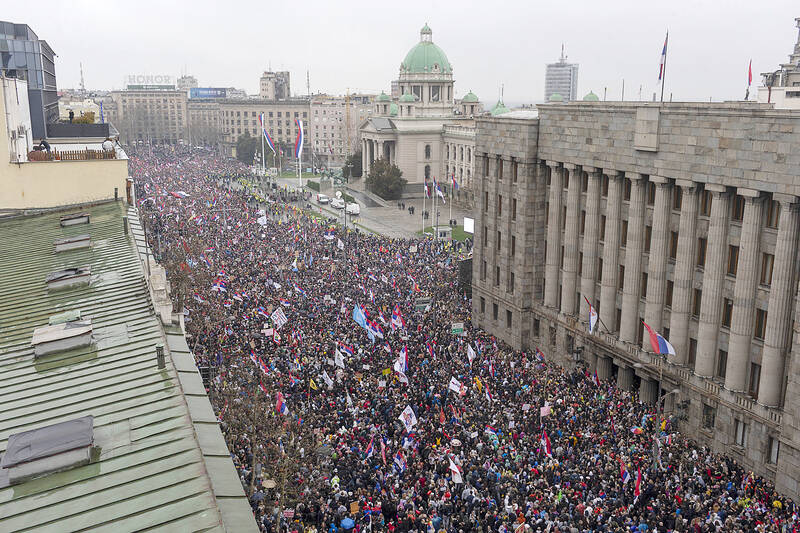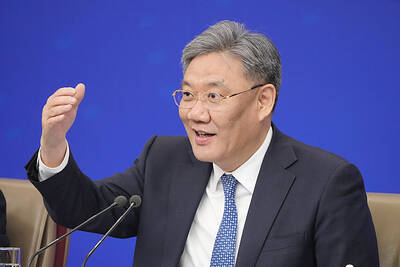A sea of people converged in Serbia’s capital, Belgrade, on Saturday in what was the largest in a series of anti-corruption demonstrations that have upended the Balkan country in recent months.
At one point the crowd stretched for nearly two kilometers, with people filling the streets in and around the parliament and the capital’s main pedestrian square.
“We have gathered in the streets primarily to express our complete dissatisfaction after years of dictatorship, lawlessness and corruption,” said one demonstrator, Ognjen Djordjevic, a 28-year-old resident from Belgrade.

Photo: AP
The movement formed after 15 people were killed when a railway station roof collapsed in the city of Novi Sad in November last year, igniting long-simmering anger over alleged corruption and lax oversight in construction projects.
After Saturday’s rally, the Serbian Ministry of Internal Affairs said that at least 107,000 people had turned out.
The Public Assembly Archive — a group that monitors crowd size — gave a much higher figure, estimating that between 275,000 and 325,000 people took to the streets. If correct, that would make Saturday’s protest one of the largest in Serbia’s recent history.
For weeks, student-led protesters have crisscrossed the country, holding rallies in Serbia’s major cities.
They have also taken their anti-corruption crusade to the rural areas and small towns that have long been the backbone of Serbian President Aleksandar Vucic’s support.
Their return to Belgrade on Saturday ramped up already compounding pressure on Vucic’s government, with several high-ranking officials, including the prime minister, Milos Vucevic, having resigned in recent months.
Saturday’s protest, like the others before it, cut across a wide spectrum of society, bringing together those aligned with the far left and right. Amid scores of Serbian flags, some waved banners calling for environmental protection, while others demanded the return of the former breakaway province of Kosovo.
Following hours of peaceful protests, police reported that there had been some “incidents and clashes among some participants” of the protests.
At about 7:20pm, a leading student group called on all protesters to exit the area near the parliament, citing security concerns after bottles and stones were allegedly thrown. The reports of scattered incidents came as fears rose over potential clashes with supporters of Vucic’s embattled government, who had also gathered in the capital.
In the days leading up to the protest, ultranationalists and militia members camped out near the parliament and the Novi Dvor, the seat of the presidency.
Ahead of the protest, layers of riot police earlier fanned out near the encampment and around the parliament.
Late on Saturday, Vucic took to the airways again.
“There were no casualties or serious injuries,” Vucic said during the national address.
“I’m proud of the police who ensured security for all participants,” he said, adding that he believed “99 percent” of students had remained peaceful.
A day earlier, Vucic had struck a defiant tone, saying he would not “let the streets set the rules in this country.”
Some analysts had earlier warned that the situation would escalate. “We can already see for a few days that the regime is trying to escalate tensions,” political analyst Srdjan Cvijic said.
Government-backed media also broadcasted increasingly inflammatory accusations, saying the students are planning to launch a “coup,” with Vucic accusing the demonstrators of organizing “large-scale violence.”
However, the day passed with no major incidents. Farmers, students, bikers and other civilians mingled along the main thoroughfares in downtown Belgrade, as a parade of tractors headed toward the parliament as crowds amassed.
Ahead of the main afternoon protest, thousands also stood for 15 minutes of silence beginning at 11:52am to honor the victims of the Novi Sad incident, with the time marking the moment of the roof’s collapse.
The ritual was repeated in the evening, as a sprawling crowd at a major traffic roundabout waved their illuminated mobile phones in the air.
“We came for justice,” said Milica Stojanovic, a biology student at the University of Belgrade. “I hope that after this protest, things will change.”

‘EYE FOR AN EYE’: Two of the men were shot by a male relative of the victims, whose families turned down the opportunity to offer them amnesty, the Supreme Court said Four men were yesterday publicly executed in Afghanistan, the Supreme Court said, the highest number of executions to be carried out in one day since the Taliban’s return to power. The executions in three separate provinces brought to 10 the number of men publicly put to death since 2021, according to an Agence France-Presse tally. Public executions were common during the Taliban’s first rule from 1996 to 2001, with most of them carried out publicly in sports stadiums. Two men were shot around six or seven times by a male relative of the victims in front of spectators in Qala-i-Naw, the center

Australia’s opposition party yesterday withdrew election promises to prevent public servants from working from home and to slash more than one in five federal public-sector jobs. Opposition leader Peter Dutton announced his conservative Liberal Party had dropped its pledge that public servants would be required to work in their offices five days a week except in exceptional circumstances. “I think we made a mistake in relation to this policy,” Dutton told Nine Network television. “I think it’s important that we say that and recognize it, and our intention was to make sure that where taxpayers are working hard and their money is

Canadian Prime Minister Mark Carney is leaning into his banking background as his country fights a trade war with the US, but his financial ties have also made him a target for conspiracy theories. Incorporating tropes familiar to followers of the far-right QAnon movement, conspiratorial social media posts about the Liberal leader have surged ahead of the country’s April 28 election. Posts range from false claims he recited a “satanic chant” at a campaign event to artificial intelligence (AI)-generated images of him in a pool with convicted sex offender Jeffrey Epstein. “He’s the ideal person to be targeted here, for sure, due to

DISPUTE: Beijing seeks global support against Trump’s tariffs, but many governments remain hesitant to align, including India, ASEAN countries and Australia China is reaching out to other nations as the US layers on more tariffs, in what appears to be an attempt by Beijing to form a united front to compel Washington to retreat. Days into the effort, it is meeting only partial success from countries unwilling to ally with the main target of US President Donald Trump’s trade war. Facing the cratering of global markets, Trump on Wednesday backed off his tariffs on most nations for 90 days, saying countries were lining up to negotiate more favorable conditions. China has refused to seek talks, saying the US was insincere and that it